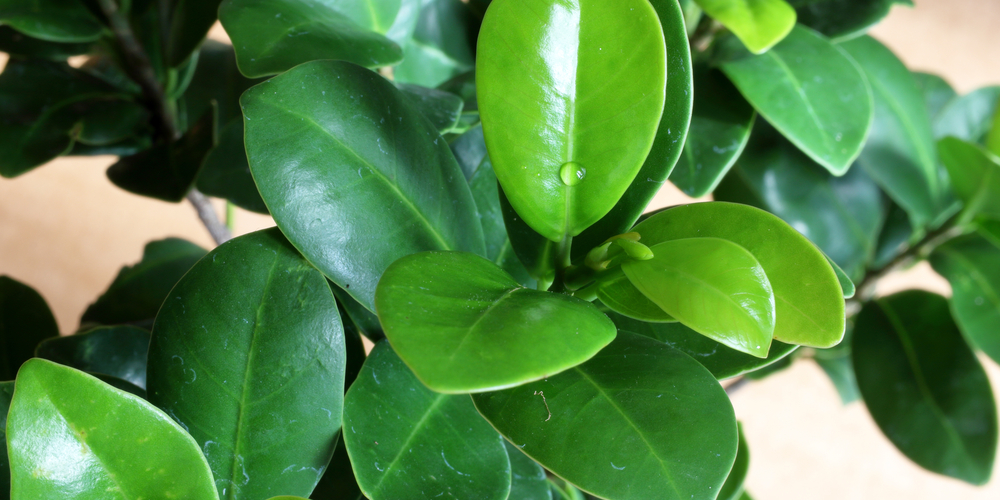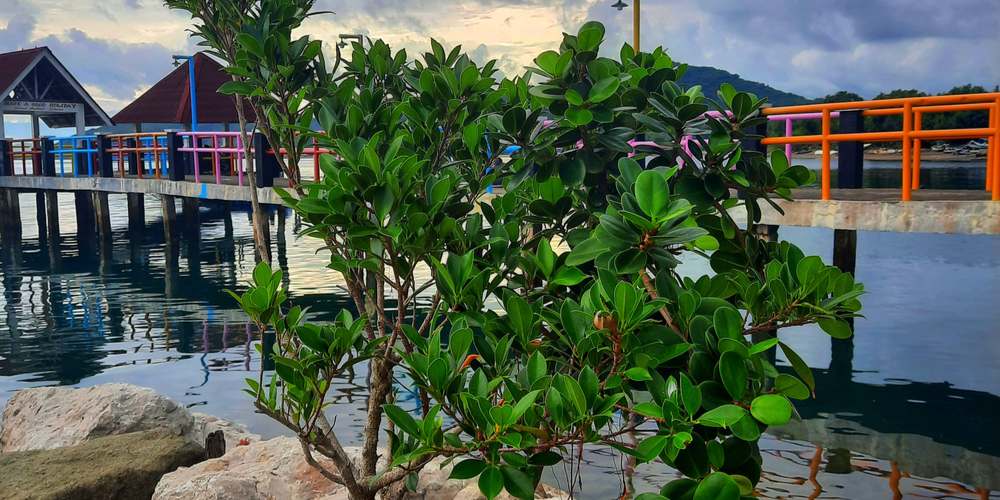Green island ficus or Ficus microcarpa is a plant from the Ficus tree. It is small and has glossy leaves and a ‘friendly’ root system. It is very robust and adaptive like other plants from the Ficus species. You can grow it outdoors not just for its appealing look but also because it can offer sunshade. However, it can also serve as a great indoor plant. Let’s look at how to grow and care for a Green Island Ficus.
What is a Green Island Ficus?

The plant’s origins aren’t that clear. However, the parent plant, that is, F. microcarpa, has been widely observed in India, Australia, China, and Southeast Asia. Generally, this tree is large and features destructive leaves. But, the Green Island variety isn’t that tall nor are its roots destructive.
Green island ficus can suit any garden or landscape design. Plus, it grows slowly, meaning that you’ll not have to prune it constantly.
Additionally, it can tolerate drought and thrive in little water. Thus, making it a suitable option for people living in the coastal areas who want a plant that can grow despite the salt sprays.
So, we now know what this plant is, but how do you care for it? Read on to learn how to plant and maintain the green island ficus.
Size and Growth
Green island can grow up to 20 feet tall and form a massive canopy in its native regions. However, the varieties sold and grown in North America can only reach 8 feet tall or even smaller if not well maintained.
Most people grow this plant as a ground cover or low hedge. Pruning helps maintain the shape and keep the plant at the desired height. Some people start trimming it when it’s still young to keep it as a Japanese bonsai tree.
Green island ficus is a slow grower, but its roots often spread quickly. For this reason, it’s not advisable to plant it close to other structures or plants.
Light, Temperature, and Humidity
Green island ficus is a tropical plant. Usually, such plants survive in warm and humid conditions. However, this plant does well in USDA hardiness zone 9-11.
It thrives well in cold and dry seasons. So if you’re growing it outside in a container, you can transfer the plant indoors when there’s a temperature drop.
Also, ensure that your plant receives bright light. However, it’s also wise to place it under partial shade since too much sunlight can burn the leaves. Make sure that your plant receives at least 6 hours of indirect bright light every day, especially if growing indoors.
Also, note that while the plant prefers a warm environment, it can do well in low temperatures of 20-30 degrees F. But it needs a frost-free climate. Therefore, you should move your plant indoors and tweak the room temperature during the cold season.
Remember to set your plant in an enclosed porch since glass windows usually trap more humidity than other areas of your house.
The best range should be around 70% when it comes to humidity. The plant can survive in high humidity. So keep the levels high to produce a beautiful and vibrant plant.
But note that the plant can do fine in lower humidity so long as it’s not below 40%. Avoid placing your plant near heaters and air conditioners as they dry the air quickly.
Soil and Transplanting
The soil should have excellent draining capabilities. This will prevent waterlogging and ensure that the plant gets enough water for hydration and nutrient absorption.
You can use the regular potting soil. But please make sure that it is of high quality and well aerated. Add sand, pumice, or perlite if you have your potting soil at home, but it is not well-draining.
On the other hand, consider adding peat moss to boost water retention if you have soil that drains quickly or is light like sandy soil.
If you grow your plant in a container, remember to transplant it after every two years to allow the soil to freshen. The best time for transplanting is in early spring, before the plant starts growing actively.
Watering and Fertilizing
Although this plant can thrive in dry areas, you shouldn’t let it dry completely. However, the watering frequency will depend on the rainfall patterns in your location. But, constantly water new plants for several days until they’re stable.
Remember to supply enough water to make the plants stronger. If you are growing them in a container, water your plants after two weeks to give enough time for the soil to absorb moisture and dry. Otherwise, you may end up waterlogging the soil.
Also, bear in mind that all plants, especially those in containers, need fertilizers to become healthy. Green island ficus isn’t different. You need to supply it with liquid feed granulated or slow-release fertilizers.
But when doing so, please follow the instructions on the packages carefully. Misusing fertilizer can harm your plant instead of helping it. We also advise that you water your plant first before fertilizing it to prevent the roots from burning. If your plant is sickly or dying, don’t use fertilizer on it.
Maintenance and Grooming
Groom your houseplant if you notice undesirable parts. Pluck off wilted or infected leaves. But remember to sterilize your pruning tools first to avoid infecting other parts of the plant.
Remove dead leaves and branches to allow the growth of new, fresh and vibrant ones. Trimming is recommended two times a year unless you notice any alarming condition on the leaves of branches. But, those that like their plant short can trim more often.
Green Island Ficus: Propagation
Propagating involves root cuttings. Note that the roots spread more quickly than the stem. Therefore, you can divide and separate them to spread the plant and allow new ones to grow.
Cut a young plant, dip the root in root hormone, then plant it in a separate starter container. Please don’t use plastic to cover it. Instead, just set the plant near a window and water it frequently.
You should notice the roots becoming a new plant after some weeks. Then, you can consider transplanting it into the ground or keeping it in the container to form a small bonsai.
Flowering and Fragrance
Green island ficus rarely produces flowers even when suitable growing and care conditions are provided. Therefore, do not have very high expectations about enormous blooms like other plants.
Most people grow it as it produces glossy, dense green leaves that offer excellent shade and establish a perimeter. However, since these garden beauties also have an attractive appearance, you can use them as an indoor plant to attract your visitor’s attention.
Pests and Diseases
The good thing about this plant is that it isn’t prone to pests and diseases. Thus you may never have to deal with them. However, ensure that you inspect regularly and be on the lookout for scale, centipede, and mealybugs.
Also, the ficus plant can get infected with fungal diseases like anthracnose disease. Root rot can also occur if you overwater your plant.
Conclusion
Green island ficus can add beauty to a landscape and garden. It requires low maintenance. And even though it is a slow grower, the plant is a worthwhile investment. Therefore, consider having it in your garden and landscape.
